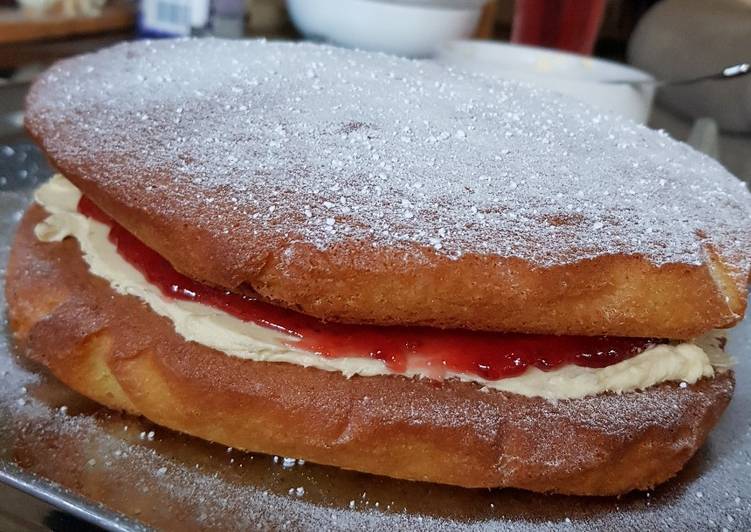Victoria sponge cake. A Victoria Sponge was the favorite sponge cake of Queen Victoria, and has since become a tried-and-true recipe for tea-time sponge cakes. Victoria Sponges are generally filled with jam, and are undecorated on the top, but you can serve each piece with a dollop of whipped cream, or shake some powdered sugar over the top if you'd like. Probably the most iconic British cake, a good Victoria sponge should be well-risen, moist, and as light as air.
 The Victoria Sponge was named after Queen Victoria, as reputedly it was her favorite cake.
Anna, the Duchess of Bedford, who has been given credit for introducing the charming art of the afternoon tea, was a lady in waiting to the queen who quickly adopted the custom of serving sponge cakes as part of the tea.
The Victoria Sponge was named after Queen Victoria, who regularly ate a slice of sponge cake with her tea, each afternoon!
You can cook Victoria sponge cake using 9 ingredients and 10 steps. Here is how you achieve it.
The Victoria Sponge was named after Queen Victoria, as reputedly it was her favorite cake.
Anna, the Duchess of Bedford, who has been given credit for introducing the charming art of the afternoon tea, was a lady in waiting to the queen who quickly adopted the custom of serving sponge cakes as part of the tea.
The Victoria Sponge was named after Queen Victoria, who regularly ate a slice of sponge cake with her tea, each afternoon!
You can cook Victoria sponge cake using 9 ingredients and 10 steps. Here is how you achieve it.
Ingredients of Victoria sponge cake
- It's of Caster sugar.
- You need of Butter.
- You need of Large eggs.
- Prepare of Self raising flour.
- It's of Baking powder.
- You need of Milk.
- It's of Icing sugar.
- It's of Vanilla extract.
- It's of Strawberry jam.
To mark Royal Garden Parties, Buckingham Palace Pastry Chef's are delighted to share this traditional recipe. If you use social media, remember to share your #royalbakes ! Mary Berry's easy Victoria sponge cake recipe is a baking classic and a tasty tea-time treat. The Victoria sponge is flavorful enough that it can be enjoyed comparatively unadorned.
Victoria sponge cake instructions
- Preheat oven to 170°c fan.
- In a large mixing bowl add 200g caster sugar and 200g softened butter. Whisk until pale and fully combined, make sure not to over whisk or the butter can split..
- Add 4 eggs to the bowl and whisk until fully combined. Again be careful not to over whisk..
- Sift 200g self raising flour and 1 tsp baking powder into the bowl. Gently fold into the mixture until fully combined. Be as gentle as you can and take your time. Air is the key to the cake being fluffy..
- Add 2 tbsp of milk and 1 tsp vanilla extract to the bowl and gently fold it into the mixture..
- Line two 20cm sandwich tins with greaseproof paper. Gently divide the mixture between the two tins as evenly as you can and smooth out..
- Put the tins into the oven and bake for 20 minutes until golden and a skewer or knife comes out clean..
- Take the cakes out of the tins and place on a wire cooling rack. Leave to cool completely..
- For the buttercream: In a large bowl add 100g softened butter. Sift 140g icing sugar onto the butter. Whisk them together until smooth. Add 1/2 tsp vanilla extract and mix..
- Spread the buttercream over one of the cakes. Then spread 170g of strawberry jam on top of the buttercream and sandwich the other cake on top. Dust the top with icing sugar and serve..
Queen Victoria's cakes, and even those of my childhood, would have been sandwiched only with jam, with a dusting of sugar over the top. The Victoria Sandwich (named after Queen Victoria) was originally shaped in a long loaf, filled, and cut into fingers or "sandwiches." It has become the quintessential round cake that every English homemaker has had in her repertoire from the time of its royal debut, both the original and, in the decades since, countless versions and incarnations. For the final technical challenge Mary Berry asked the bakers to make this simple sponge with homemade jam and buttercream - without a recipe. This Victoria sandwich recipe by Mary Barry is. But Tammy's favorite dessert by far was Victoria sponge cake.